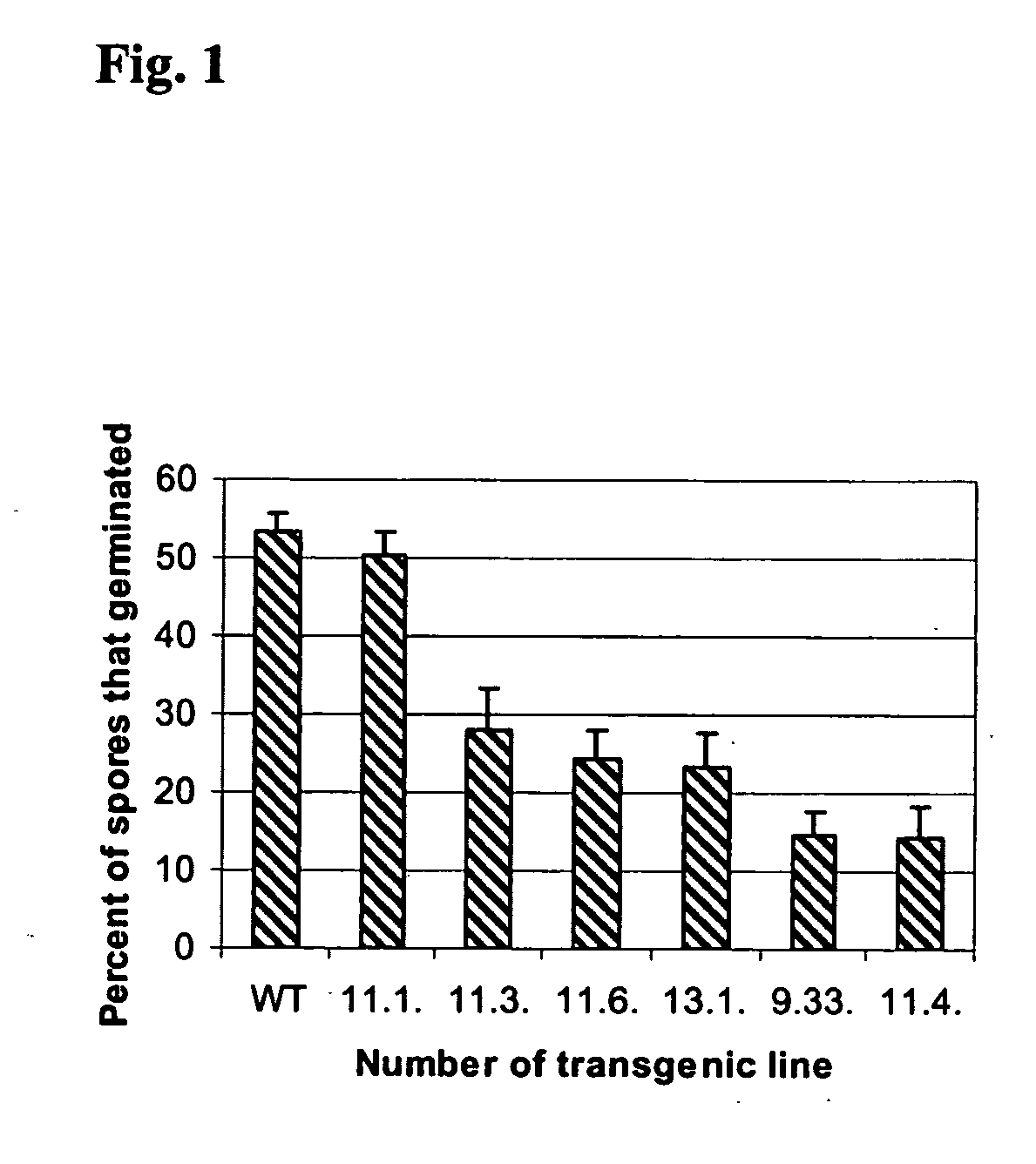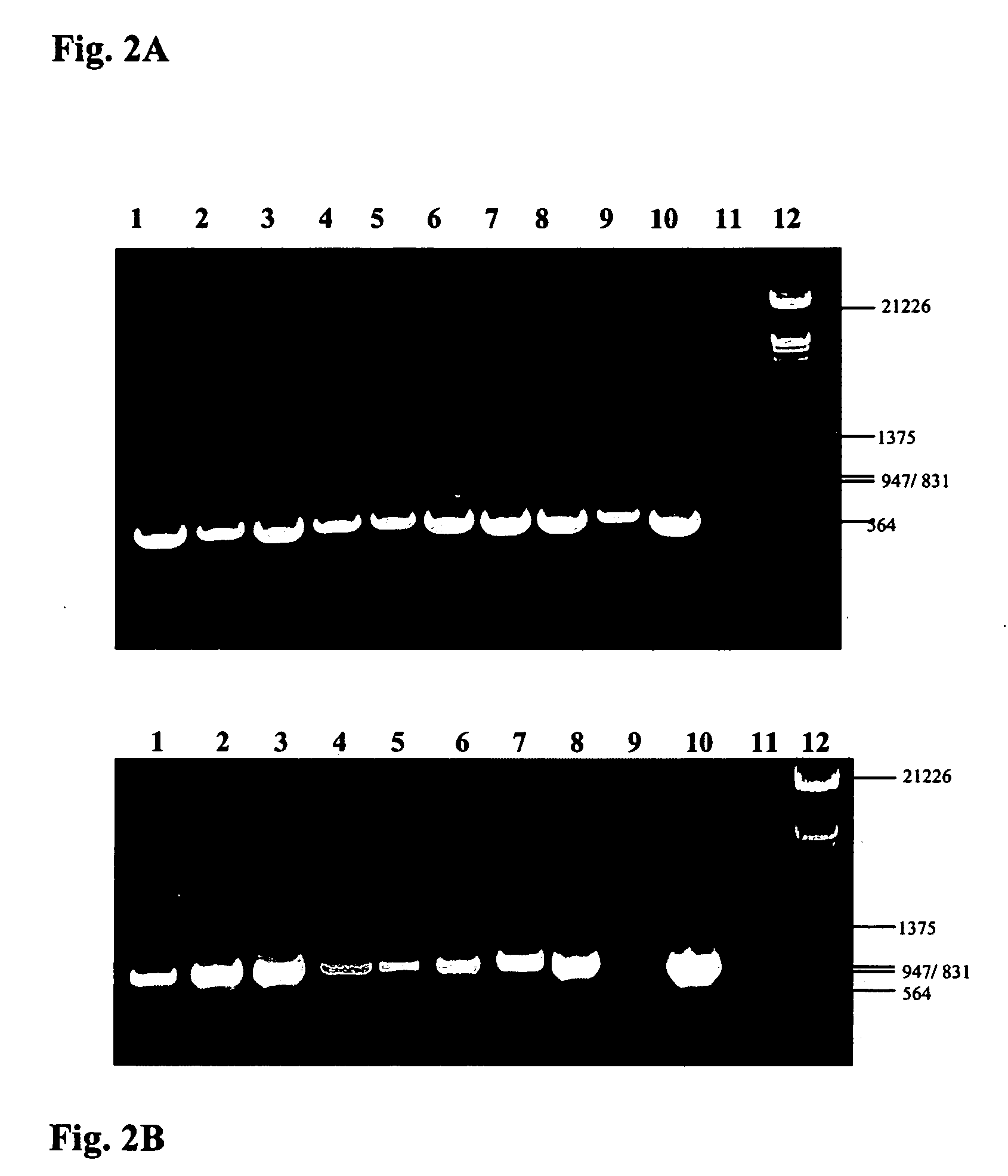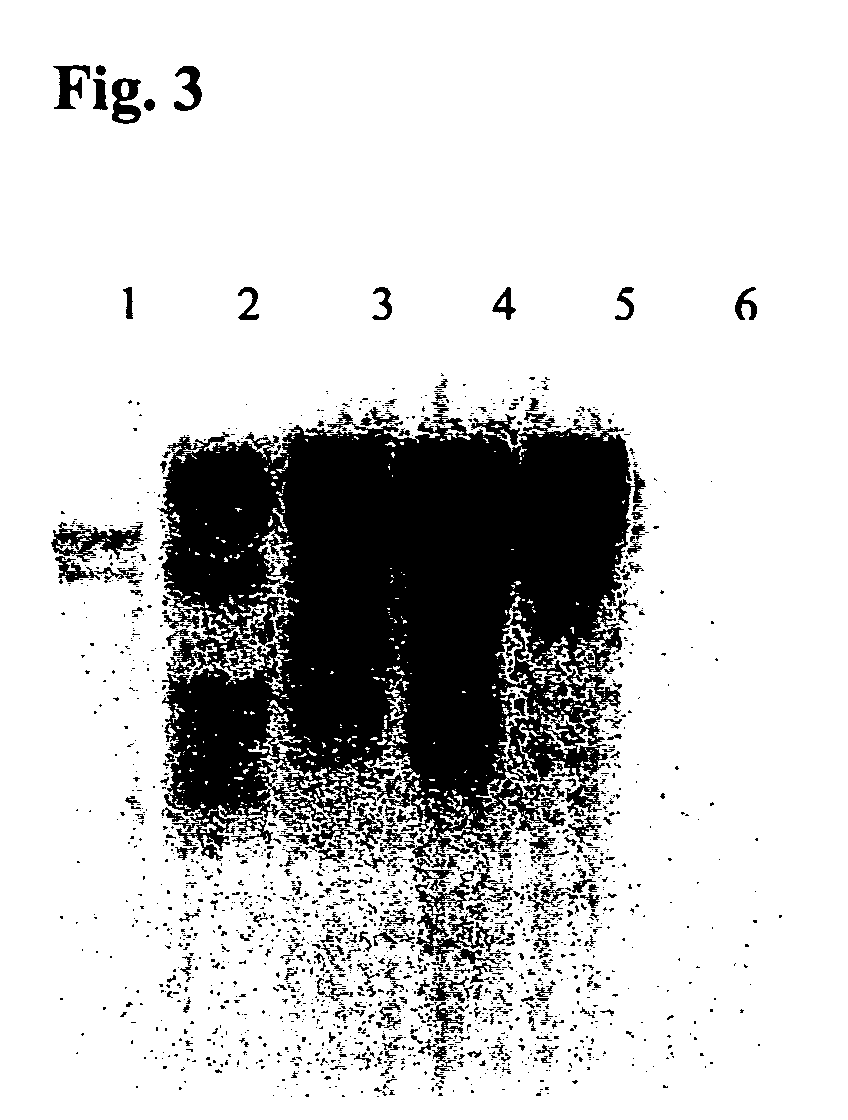Transgenic disease resistant banana
- Summary
- Abstract
- Description
- Claims
- Application Information
AI Technical Summary
Benefits of technology
Problems solved by technology
Method used
Image
Examples
example 1
Initiation and Propagation of Banana Embryogenic Callus
[0106] Immature male flowers of banana (Musa AAA cv. ‘Grand Nain’) were surface sterilized with 10% sodium hypochlorite for 30 minutes, dissected and incubated in M1 medium (see content in Table 1 below) under a reduced light intensity (50-100 lux) at 25° C. Following 3-5 months of incubation in M1 medium, yellow embryogenic calli were transferred to M2 medium (see content in Table 1 below) and incubated at 27° C. in the dark for at least four months to promote embryogenesis.
TABLE 1Media for initiation and maintenance of embryogenic calliIngredientsM1M2Salt mixtureMSMSVitamin mixtureMSMSBiotin, mg 1−111Sucrose, g 1−130-4544.5NAA mg 1−112,4-D, mg 1−141IAA mg 1−11Glutamine, mg−1100Malt extract, mg 1−1100DTT, mg −150Agarose, g 1−17Gelrite (Duchefa), g 1−12.52pH5.75.3
MS = According to Murashig and Skoog, 1962)
NAA = α-naphthalane acetic acid
IAA = Indole aetic acid
DTT = 2,4-dichlorophenoxy acetic acid (2,4 D)
example 2
Regeneration of Banana Plants from Embryogenic Calli
[0107] Embryogenic calli were incubated in E1 or E3 medium (see content in Table 2 below) at 27° C. in the dark for 2-3 months and then transferred to M3 medium for additional incubation under similar conditions. During incubation, abundant primary and secondary embryos (i.e., somatic embryos which developed from pre-existing embryos) were formed.
TABLE 2 Media for induction of banana embryosIngredientsE1E3M3M3aMineral saltsSHSHSHMSVitaminsMSMSMSMWBiotin, mg 1−11111Glutamine, mg 1−1100100100100Malt extract, mg 1−1100100100100Proline, m 1−1230.2230.2230.2230.2Adenine sulfate, mg 1−1101Maltose, g 1−11510.510.5Sucrose, g 1−1454545.544.5NAA, mg 1−10.20.20.20.2Kinetin, mg 1−10.10.12 iP, mg 1−10.20.140.14BA, mg 1−10.2Zeatin riboside, mg 1−10.050.050.050.05Gelrite, g 1−12.72.72.72.5pH5.35.35.35.3
SH = According to Schenk and Hildenbrandt (1972)
MS = According to Murasbig and Skoog (1962)
MW = ccording to Morel and Wetinore.
NAA = α-napht...
example 3
Construction of a Nucleic Acid Construct Comprising Genes Encoding the Enzymes Endochitinase, Superoxide Dismutase and Stilbene Synthase (Disease Resistant Traits)
[0109] Construction of pBluscript IISK-ESR: A polynucleotide fragment comprising the Trichoderma harzianum endochitinase gene ThEn-42 (ESR; SEQ ID NO: 1; Lorito et al., 1993). A fragment HindIII / EcoRI of pBIN19ESRI, carrying the duplicated 35S promoter, the AMV leader 5′ to the ESR fragment and the NOS terminator was cloned into the HindIII / EcoRI sites of the plasmid pBluescript II SK (Stratagene) under the control of the cauliflower mosaic virus 35S subunit promoter (CaMV-35S; Benfey et al. EMBO J. 9: 1685-1696, 1990) and the Agrobacterium nopaline synthase (NOS) terminator.
[0110] Construction of pBluescript IISK-ESR-SOD: A 840 bp polynucleotide fragment comprising cDNA of tomato superoxide dismutase gene (SOD; SEQ ID NO: 3; Perl et al., 1993) and NOS terminator was obtained as an EcoRI fragment of p492-P31A (Perl et al...
PUM
| Property | Measurement | Unit |
|---|---|---|
| Mass | aaaaa | aaaaa |
| Mass | aaaaa | aaaaa |
| Mass | aaaaa | aaaaa |
Abstract
Description
Claims
Application Information
 Login to View More
Login to View More - R&D
- Intellectual Property
- Life Sciences
- Materials
- Tech Scout
- Unparalleled Data Quality
- Higher Quality Content
- 60% Fewer Hallucinations
Browse by: Latest US Patents, China's latest patents, Technical Efficacy Thesaurus, Application Domain, Technology Topic, Popular Technical Reports.
© 2025 PatSnap. All rights reserved.Legal|Privacy policy|Modern Slavery Act Transparency Statement|Sitemap|About US| Contact US: help@patsnap.com



